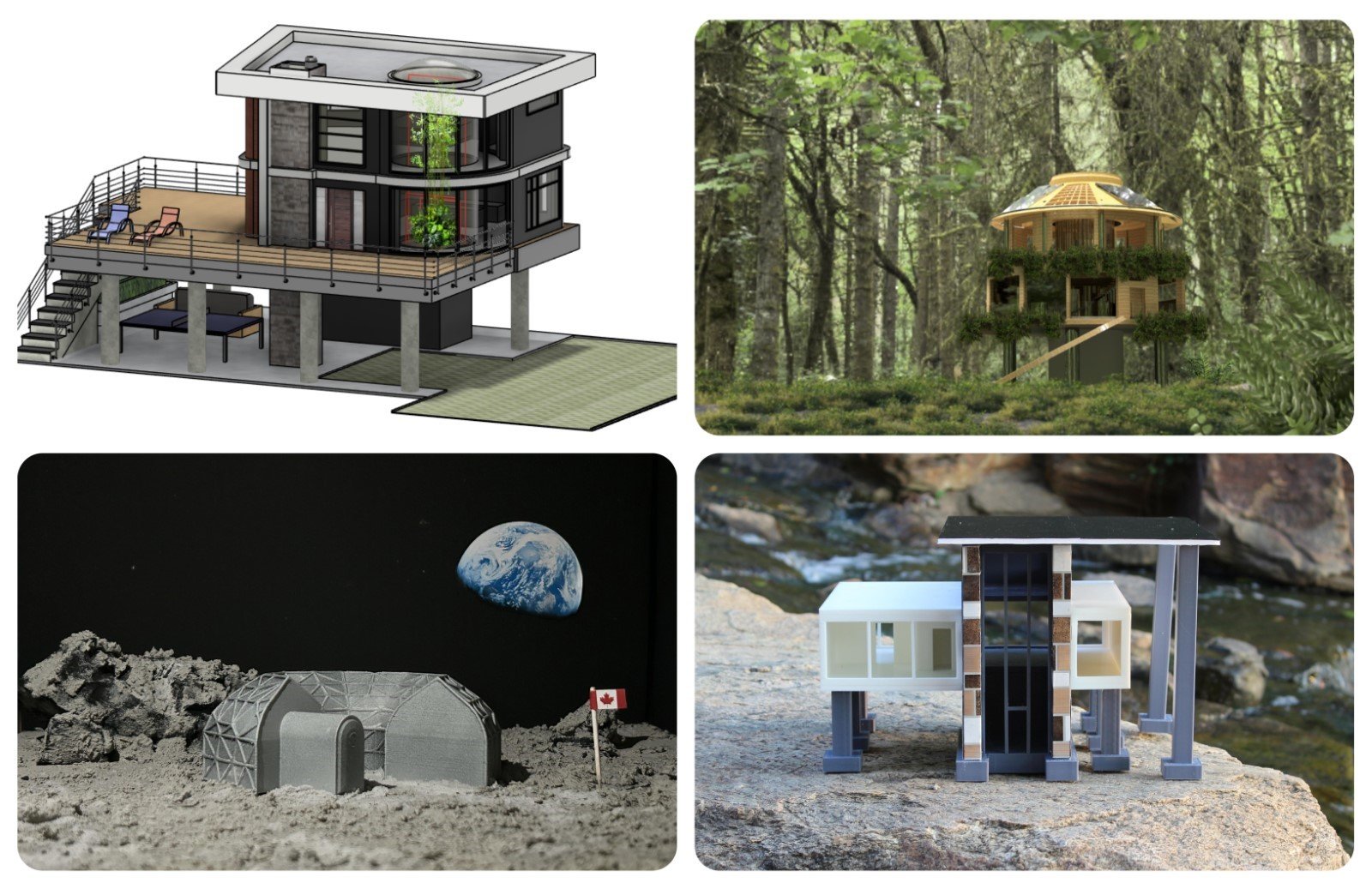Autodesk’s “Make it Resilient” program rewards sustainable habitat designs
Aurelia Institute provided starter CAD designs and judging for the competition.
The four winning designs in the 2024 Make it Resilient compeition.
Autodesk’s “Make it Real” program encourages young people to engage with their communities by applying the design thinking process to real problems related to construction and the built environment. A key initiative of the program this year was the "Make It Resilient" Scholarship Award, which challenged high school students to imagine new ways to build for extreme environments. Winners of the contest earned scholarship prizes totaling $50,000 to support educational expenses such as tuition, books, room and board, transportation, and childcare.
Aurelia Institute was proud to participate in the “Make it Resilient” program. First we provided 3D models of our TESSERAE Pavilion design in Tinkercad and Autodesk Fusion as starter designs for competitors; and then Senior Mechanical Engineer Evan Hilgemann acted as a judge in the competition.
Read Autodesk’s full article here: Inspiring a resilient construction workforce: Four young changemakers and the AECO professionals who are lighting their way. Below, read an excerpt featuring Evan and the 2nd-place winner, Jane Serene Liou.
Healthy, sustainable building
Jane Serene Liou, a junior at Mountainview High School in Mountainview, California, won a $1,000 2nd Prize for her design of a sustainable habitat for the Amazon Rainforest. The goal of her design was to create a home for a family of four, including a park ranger, so that they could coexist peacefully with nature while still meeting their modern-day needs. She was also interested in exploring how exposure to nature can improve our mental health. Other topics she researched to create her design included the landscape, climate, indigenous tribes, and architectural traditions of the Amazon Rainforest.
Evan Hilgemann is Aurelia Institute's Senior Mechanical Engineer, and his career interests focus on exploring Earth and space through the development of hardware for extreme environments. Evan is currently leading an effort to mature technologies related to advanced space stations and supports other programs across Aurelia's portfolio. Previously, he was a mechanical engineer at NASA's Jet Propulsion Laboratory where he contributed to a wide array of projects ranging from early-stage technology developments to flight hardware design and mission operations.
Aurelia Institute’s TESSERAE Pavilion was the inspiration for the contest with its vision of a future where life in space is welcoming, enticing, and practically accessible for all people. Students could use a starter Autodesk Tinkercad or Autodesk Fusion model provided by Aurelia Institute, a resident team in the Autodesk Technology Centers Research Residency Program, or create their own.
Jane Serene Liou, Junior, Mountainview High School, Mountainview, California
Tell us about your submission. What inspired you to enter the design challenge?
I was inspired to enter the Make it Resilient Autodesk challenge because I wanted to challenge myself as an aspiring architect and designer. The design challenge was not only an opportunity to win a scholarship to help me pursue my passion for architecture, but it was also an opportunity for me to learn CAD skills for the first time, learn more about architecture and the related industries of construction and engineering, and be able to practice the design process comprehensively. Going into the competition, I knew that I would have to devote lots of time towards designing a viable habitat in the extreme environment, as well as learning the actual Autodesk software (I used Fusion) from scratch. However, during the rigorous design process, I learned so much more than I expected. Not only was I able to improve my 3D modeling skills, but I was also able to engage in deep problem-solving, learn about sustainable materials and energy conservation strategies through extensive research, and overall, gain a newfound appreciation for the work of architects. I am so glad to have taken up this challenge and incredibly thankful that Autodesk and Instructables have created this opportunity for high schoolers to explore and expand on their passions.
Why are you inspired to pursue a career in the AECO industry? What impact do you hope to make in the industry?
I am inspired to pursue a career in the AECO industry because I believe this industry has such a profound and direct impact on individuals, communities, and the environment. I have witnessed how thoughtful and considerate architecture and urban planning can create a positive impact on communities by sustainably addressing community needs, responding to their unique culture, and improving the well-being of individuals in the community. I have also witnessed how poorly designed architecture can have adverse impacts on the health of both the inhabitants and the planet. Thus, I aspire to use my passion for architecture to create a better, more sustainable built environment for future generations.
Evan Hilgemann, Senior Mechanical Engineer, Aurelia Institute, Cambridge, MA
Why did you want to judge this competition? What makes you excited about this particular challenge?
This challenge really gets to the heart of what we are working on at Aurelia Institute. We generally focus on life in space where living conditions are often austere and not very welcoming for people who are not professional astronauts. Our goal is to envision and create a future where the unique environment of space can truly be embraced and enjoyed by all. I really enjoyed seeing the variety of interpretations of the prompt and how students applied it to different environments and situations; it clearly showcased their talent for creative design!
What’s the best advice you can give aspiring engineers or AECO professionals?
Build things! Program a robot. Try to fix your bike. Make a bookshelf. It doesn't really matter what. Just get your hands dirty with something that captures your curiosity and see where it takes you. It will almost certainly pay off later in your career.
Could you recommend resources for developing stronger 3D literacy and design skills?
Nothing beats practice. For students who might not have access to tools or machines, check out your local library. Many districts now have well equipped makerspaces with active communities and volunteers who can help students improve their skills.


